The Intel Skylake-X Review: Core i9 7900X, i7 7820X and i7 7800X Tested
by Ian Cutress on June 19, 2017 9:01 AM ESTBenchmarking Performance: CPU Rendering Tests
Rendering tests are a long-time favorite of reviewers and benchmarkers, as the code used by rendering packages is usually highly optimized to squeeze every little bit of performance out. Sometimes rendering programs end up being heavily memory dependent as well - when you have that many threads flying about with a ton of data, having low latency memory can be key to everything. Here we take a few of the usual rendering packages under Windows 10, as well as a few new interesting benchmarks.
Corona 1.3
Corona is a standalone package designed to assist software like 3ds Max and Maya with photorealism via ray tracing. It's simple - shoot rays, get pixels. OK, it's more complicated than that, but the benchmark renders a fixed scene six times and offers results in terms of time and rays per second. The official benchmark tables list user submitted results in terms of time, however I feel rays per second is a better metric (in general, scores where higher is better seem to be easier to explain anyway). Corona likes to pile on the threads, so the results end up being very staggered based on thread count.
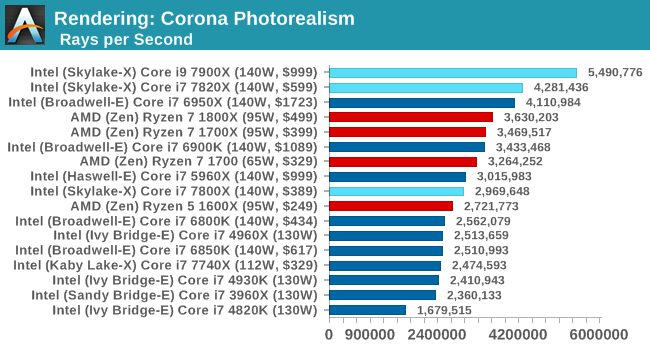
Blender 2.78
For a render that has been around for what seems like ages, Blender is still a highly popular tool. We managed to wrap up a standard workload into the February 5 nightly build of Blender and measure the time it takes to render the first frame of the scene. Being one of the bigger open source tools out there, it means both AMD and Intel work actively to help improve the codebase, for better or for worse on their own/each other's microarchitecture.
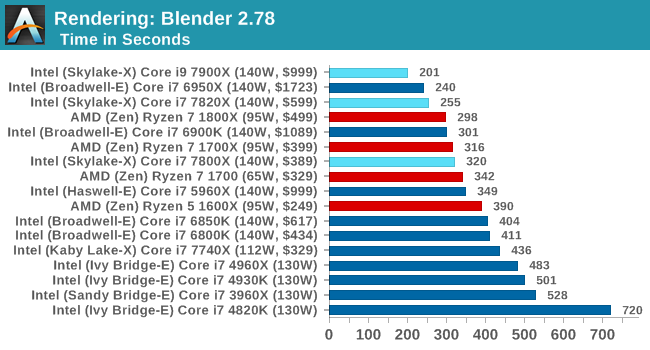
LuxMark
As a synthetic, LuxMark might come across as somewhat arbitrary as a renderer, given that it's mainly used to test GPUs, but it does offer both an OpenCL and a standard C++ mode. In this instance, aside from seeing the comparison in each coding mode for cores and IPC, we also get to see the difference in performance moving from a C++ based code-stack to an OpenCL one with a CPU as the main host.
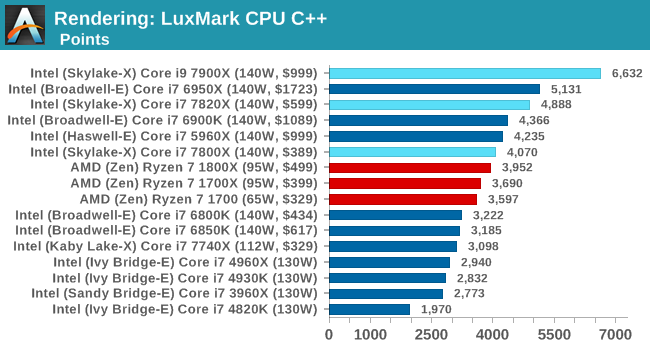
POV-Ray 3.7b3
Another regular benchmark in most suites, POV-Ray is another ray-tracer but has been around for many years. It just so happens that during the run up to AMD's Ryzen launch, the code base started to get active again with developers making changes to the code and pushing out updates. Our version and benchmarking started just before that was happening, but given time we will see where the POV-Ray code ends up and adjust in due course.
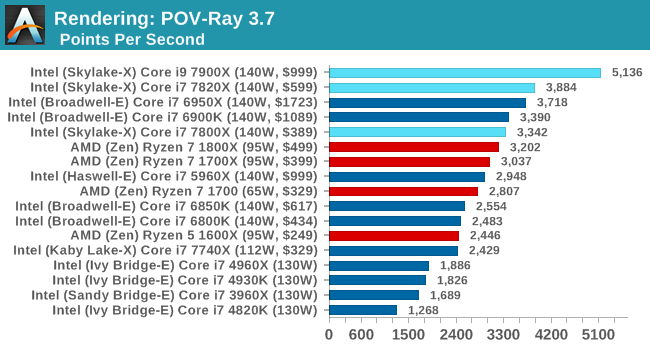
Cinebench R15
The latest version of CineBench has also become one of those 'used everywhere' benchmarks, particularly as an indicator of single thread performance. High IPC and high frequency gives performance in ST, whereas having good scaling and many cores is where the MT test wins out.
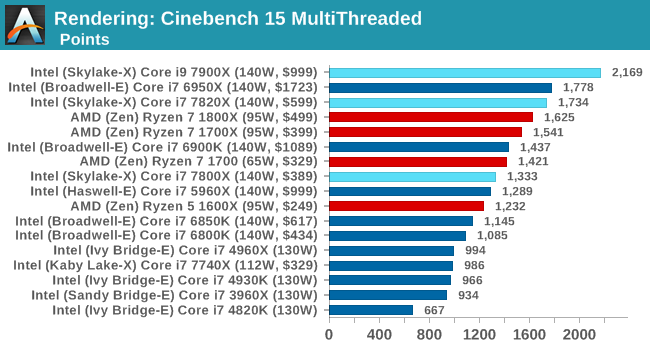
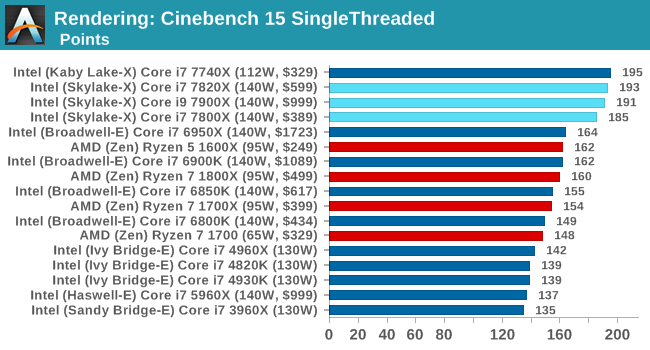










264 Comments
View All Comments
Slappi2 - Monday, June 19, 2017 - link
Running 1080s, doubt I'll notice.Luckz - Monday, June 19, 2017 - link
That's an impressive review / article considering the source.prophet001 - Monday, June 19, 2017 - link
The TDP on the chip is 140W. If they can't cool it then there's a problem with the heat spreader.How well it overclocks is another point of discussion separate from this one.
prisonerX - Monday, June 19, 2017 - link
And yet the only reason you're seeing it at all is becuase of AMD. You epitomise the pure, untrammeled genius of typical Intel customers.Spunjji - Tuesday, June 20, 2017 - link
This is lost on Slappi.FreckledTrout - Monday, June 19, 2017 - link
Slappi2, you reading the same charts? Also have you seen game reviews on other sites. The 1800x holds its own pretty well compared to t he 7820x 8-core, yes the 7820x is faster but not by a huge margin. We don't have Thredripper just yet to see AMD's 10 core comparison so saying Intel's 10 core is killing AMD's 8-core models is a bit disingenuous.AnandTechReader2017 - Monday, June 19, 2017 - link
The review is missing power consumption, clock speed and current price.At no point is it stated what clock speed anything is running at, it could be that Ryzen is running at base and Intel running overclocked (as speedshift would allow). There are also no comparisons with speedshift on/off.
There is no mention of power draw, the Intel processors are all using a 112/130/140W envelope, but are probably way below that with base, while Ryzen is 95/65W with no mention if overlocked above that envelope or underclocked.
If you check Amazon, one can get the R7 1800X for $439 versus the $499 they posted.
Also, the top Intel chips are competing with Thread Ripper, not Ryzen 7.
You're probably going to accuse me of fanboyism, I just don't like it if so many test details are missing. There is also no mention of temperature at max load, etc.
AnandTechReader2017 - Monday, June 19, 2017 - link
To add: They also have 2666MHz and 3000MHz RAM, yet they don't state what clock speed the test is run at.There is so much information missing.
Ian Cutress - Monday, June 19, 2017 - link
Power consumption is added. Sorry, I'm currently half-way around the world suffering jet lag - I had the graph compiled, I just forgot to write about it. It's been added.Clock Speed: As per the first page.
Current Pricing: As per the first page.
With regards the recent price drops from AMD on the Ryzen chips - everything seems to point that this is distributor driven. We've not seen anything official from AMD (such as price lists) that confirm an official price drop. If you have a link to that, please share.
On the DRAM: our standard policy as with every review is to run JEDEC for the maximum officially supported frequency. Nothing changes in this review. So that's DDR4-2666 for the 7900X and 7820X, and DDR4-2400 for the 7800X.
Tamz_msc - Monday, June 19, 2017 - link
What benchmark was used for the power consumption data?